Histogram:
In a typical 8-bit image, there are ![]() discrete gray scale levels
from 0 to
discrete gray scale levels
from 0 to ![]() . The histogram of an image represents the
density probability distribution of the pixel values in the image over the
entire gray scale range. The ith entry of the histogram is
. The histogram of an image represents the
density probability distribution of the pixel values in the image over the
entire gray scale range. The ith entry of the histogram is ![]() (
(
![]() ) for the probability of a randomly chosen pixel
to have the gray level
) for the probability of a randomly chosen pixel
to have the gray level ![]() , where
, where ![]() is the number of pixels of gray
level
is the number of pixels of gray
level ![]() in an image of size
in an image of size ![]() . Given
. Given ![]() , we can also find
the cumulative distribution function:
, we can also find
the cumulative distribution function:
![\begin{displaymath}
H[j]=\sum_{i=0}^j h[i],\;\;\;\;\;\;\;(j=0,\cdots,L-1)
\end{displaymath}](img9.png)
![\begin{displaymath}
H[L-1]=\sum_{i=0}^{L-1} h[i]=1
\end{displaymath}](img10.png)
Gray level mapping:
The appearance (brightness, contrast, etc.) of an image can be modified
according to various needs by a gray level mapping function specified by
the user:
Programming issues:
The above mapping functions can be carried out for each of the pixels in
the image. However, this is not the most efficient way computationally.
A better way for implementing the function mapping is to use a
lookup table which stores the pre-computed mapping for each of the
![]() gray levels. The gray level of a pixel in the input
image is used as the address to the table and the content of the table
entry is used as the gray level of the corresponding pixel of the output
image. By using the lookup table, the mapping function only needs to be
carried out
gray levels. The gray level of a pixel in the input
image is used as the address to the table and the content of the table
entry is used as the gray level of the corresponding pixel of the output
image. By using the lookup table, the mapping function only needs to be
carried out ![]() times, instead of
times, instead of ![]() (
(![]() ) times (size of the
image).
) times (size of the
image).
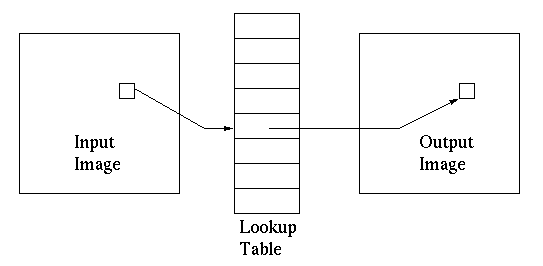
Common mapping functions:
Here are some common gray scale mapping functions ![]() :
:
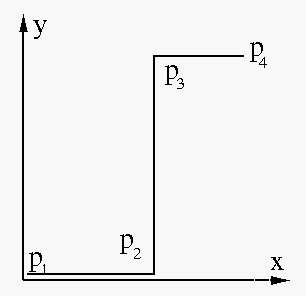
As a special case of piecewise linear mapping, thresholding is a simple way to do image segmentation, in particular, when the histogram of the image is bimodal with two peaks separated by a valley, typically corresponding to some object in the image and the background. A thresholding mapping maps all pixel values below a specified threshold to zero and all above to 255.
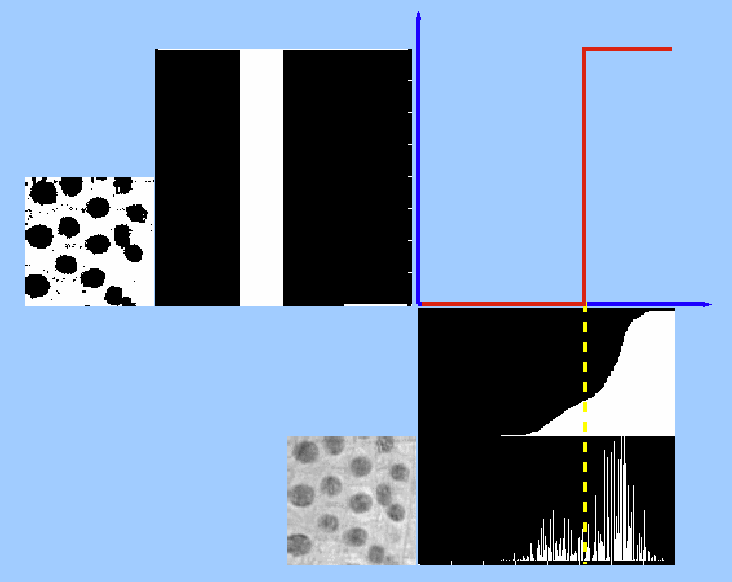
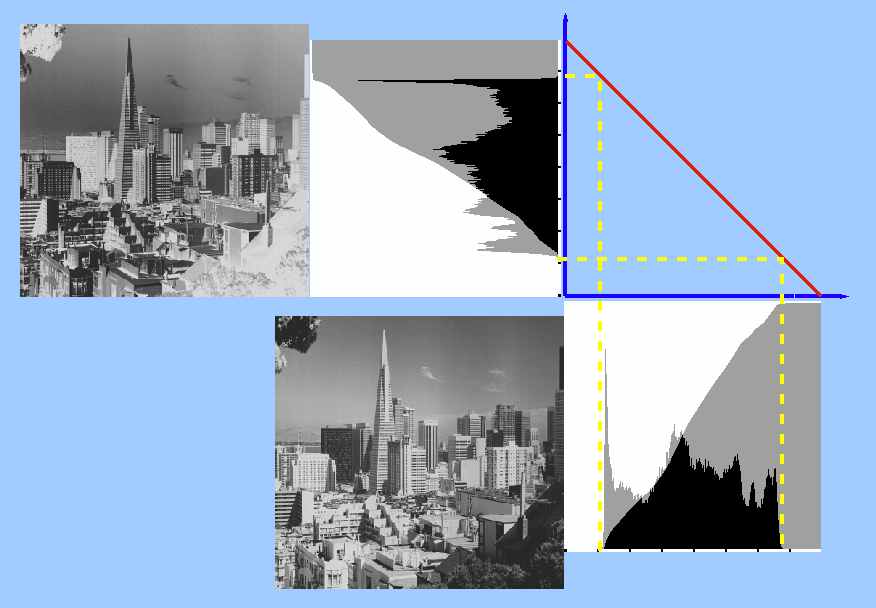
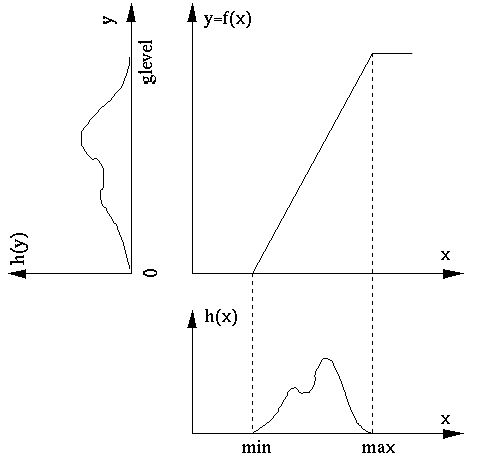

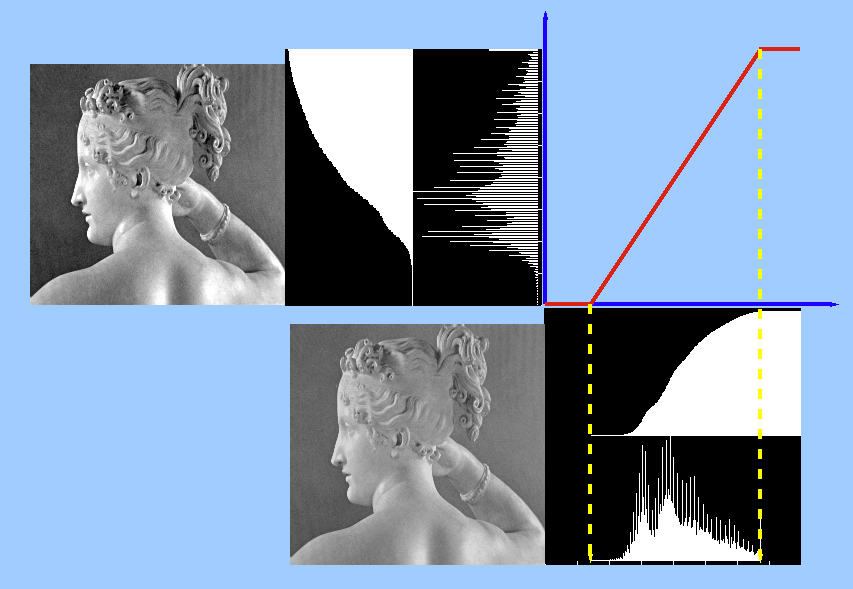
If in the image there are only a small number of pixels close to minimum
gray level 0 and the maximum gray level ![]() , and the gray level
of most of the pixels are concentrated in the middle range (gray) of the
histogram, the above linear stretch method based on the minimum and
maximum gray levels has very limited effect (as the slope
, and the gray level
of most of the pixels are concentrated in the middle range (gray) of the
histogram, the above linear stretch method based on the minimum and
maximum gray levels has very limited effect (as the slope
![]() is very close to 1).
is very close to 1).
In this case we can push a small percentage (e.g., ![]() ,
, ![]() ) of gray
levels at the two ends of the histogram toward 0 and
) of gray
levels at the two ends of the histogram toward 0 and ![]() .
.
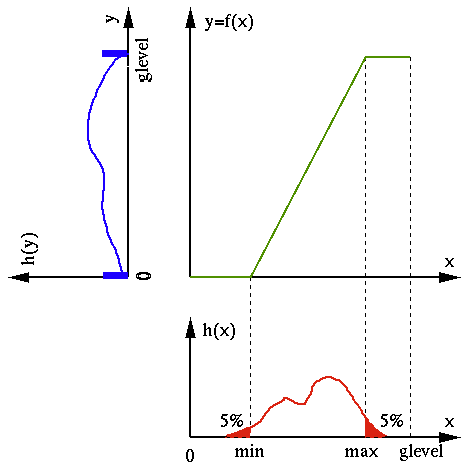
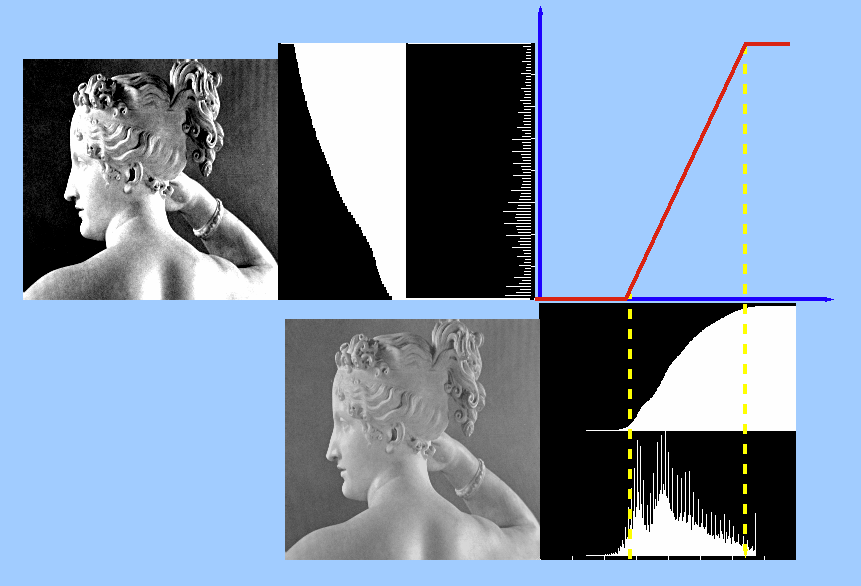
A mapping function can be specified by a set of ![]() break-points
break-points
![]() , with neighboring points connected by
straight lines, such as shown here:
, with neighboring points connected by
straight lines, such as shown here:
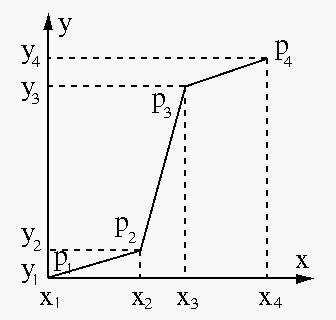
For example, to increase the contrast of the image of Paolina, we can linearly stretch the gray scales of the image so that the darkest and brightest gray levels are mapped to 0 and 255, respectively.
Code Segments:
![\begin{displaymath}
\par
\; for\; (i=0;\;i<L;\;i++)\; \{
\par
\;\;\;\; h[i]=0;\;...
...or\; (i=1;\;i<L;\;i++)\;
\par
\;\;\;\; H[i]=H[i-1]+h[i];
\par
\end{displaymath}](img33.png)
Assume ![]() and
and ![]() are fractions such as
are fractions such as ![]() or
or ![]() .
.
![\begin{displaymath}
\par
\; w=0; \;\;min=0;
\par
\; while\; (w<cut\_low)
\par
\;...
...par
\; while\; (w<cut\_high)
\par
\;\;\;\;\; w+=h[max--];
\par
\end{displaymath}](img38.png)
![\begin{displaymath}
\par
\; slope=(L-1)/(max-min);
\par
\; for \;(i=0; \;i<L; \;...
...up[i]=L-1;
\par
\; \;\; else\;\; lookup[i]=slope*(i-min);
\par
\end{displaymath}](img39.png)
![\begin{displaymath}
\par
\; for\;(i=0;\;i<M;\; i++)
\par
\; \;\;for\;(j=0;\; j<N;\; j++)
\par
\; \;\;\;\; y[i][j]=lookup[x[i][j]];
\par
\end{displaymath}](img40.png)